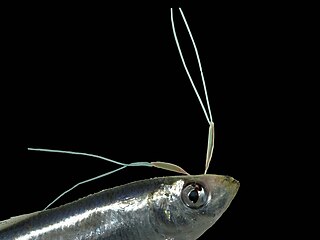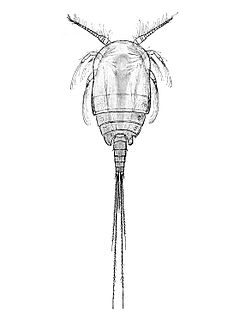Related Research Articles

Copepods are a group of small crustaceans found in nearly every freshwater and saltwater habitat. Some species are planktonic, some are benthic, a number of species have parasitic phases, and some continental species may live in limnoterrestrial habitats and other wet terrestrial places, such as swamps, under leaf fall in wet forests, bogs, springs, ephemeral ponds, and puddles, damp moss, or water-filled recesses (phytotelmata) of plants such as bromeliads and pitcher plants. Many live underground in marine and freshwater caves, sinkholes, or stream beds. Copepods are sometimes used as biodiversity indicators.
Tantulocarida is a highly specialised group of parasitic crustaceans that consists of about 33 species, treated as a subclass of the class Hexanauplia. They are typically ectoparasites that infest copepods, isopods, tanaids, amphipods and ostracods.

The Cyclopoida are an order of small crustaceans from the subclass Copepoda. Like many other copepods, members of Cyclopoida are small, planktonic animals living both in the sea and in freshwater habitats. They are capable of rapid movement. Their larval development is metamorphic, and the embryos are carried in paired or single sacs attached to first abdominal somite.

Calanus is a genus of marine copepod in the family Calanidae. The genus was split in 1974, with some species being placed in a new genus, Neocalanus. The following species are recognised:

Poecilostomatoida are an suborder of copepods. Although it was previously considered a separate order, recent research showed it to be nested within the Cyclopoida
Erebonectes is a genus of crustacean in family Epacteriscidae, containing two troglobitic species. E. nasioticus was discovered in Bermuda and described in 1985; it is listed as critically endangered on the IUCN Red List. E. macrochaetus was found on Middle Caicos and described in 1994.
Paracyclopia is a genus of copepods in family Pseudocyclopiidae, containing only the species P. naessi. It is endemic to Bermudan karsts and is critically endangered.

The Cyclopidae are a family of copepods containing more than half of the 1,200 species in the order Cyclopoida in over 70 genera.
Karllangia is a genus of marine copepods. Its name commemorates the Swedish carcinologist Karl Georg Herman Lang. The genus contains five species:

Pennellidae is a family of copepods, containing numerous genera, including:
Hamaticolax is a genus of parasitic copepods belonging to the family Bomolochidae. Its members can only be distinguished from the closely related genus Acantholochus by the presence of an accessory process on the claw of the maxillipeds. It includes the following species:

Misophrioida is an order of copepods, containing the following families:
Lernaeopodidae is a family of parasitic copepods. The females are typically large and fleshy, and attach to the host permanently using a plug made of chitin called the bulla. The males cling on to the females using their antennae. The family contains the following genera:
Parastenocarididae is a family of copepods in the order Harpacticoida adapted to life in groundwater. It contains the following genera:
Philichthyidae is a family of copepods, containing the following genera:

Lepeophtheirus is a genus of sea lice. The best-known species is L. salmonis, the salmon louse. Other species include L. pectoralis, which uses flatfish as its host, particularly the European flounder, and is also the type species of the genus Lepeophtheirus.
Eudactylina corrugata is a species of parasitic copepod found on the little skate and the thorny skate that is only known from St. Andrews, New Brunswick and Woods Hole, Massachusetts.
Eudactylina is a genus of copepods that parasitise elasmobranch fishes. It contains the following species:
Tracheliastes is a genus of parasitic copepods, containing the following species:
Mesocyclops longisetus is a species of freshwater copepod in the family Cyclopidae. Two subspecies are accepted, Mesocyclops longisetus curvatus Dussart, 1987, and Mesocyclops longisetus longisetus. It has a neotropical distribution.
References
- ↑ T. Chad Walter (2012). Walter TC, Boxshall G (eds.). "Procolobomatus". World of Copepods database. World Register of Marine Species . Retrieved April 27, 2013.